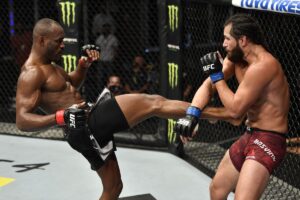Trends and Takes: Week 8
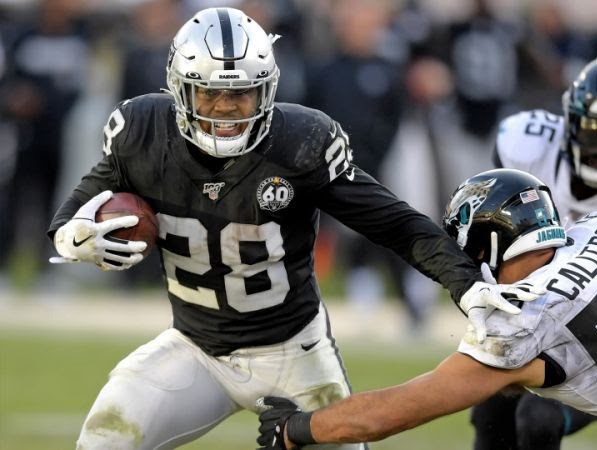
Written by Timothy Lewis (@TrendsAndTakes) — October 29th, 2020
The seventh week of the 2020 NFL season has come and gone! In other words, we have a eight-game sample size to spot trends and develop takeaways. Welcome to season three of this column! If you’re not familiar, I use this time to look at numbers and tell you what I make of them. This year, I will be offering additional Buy/Sell/Drop/hold criteria. Statistics are courtesy of advanced analytics goldmine, PlayerProfiler, and trusty dusty Pro-Football-Reference.
James Robinson
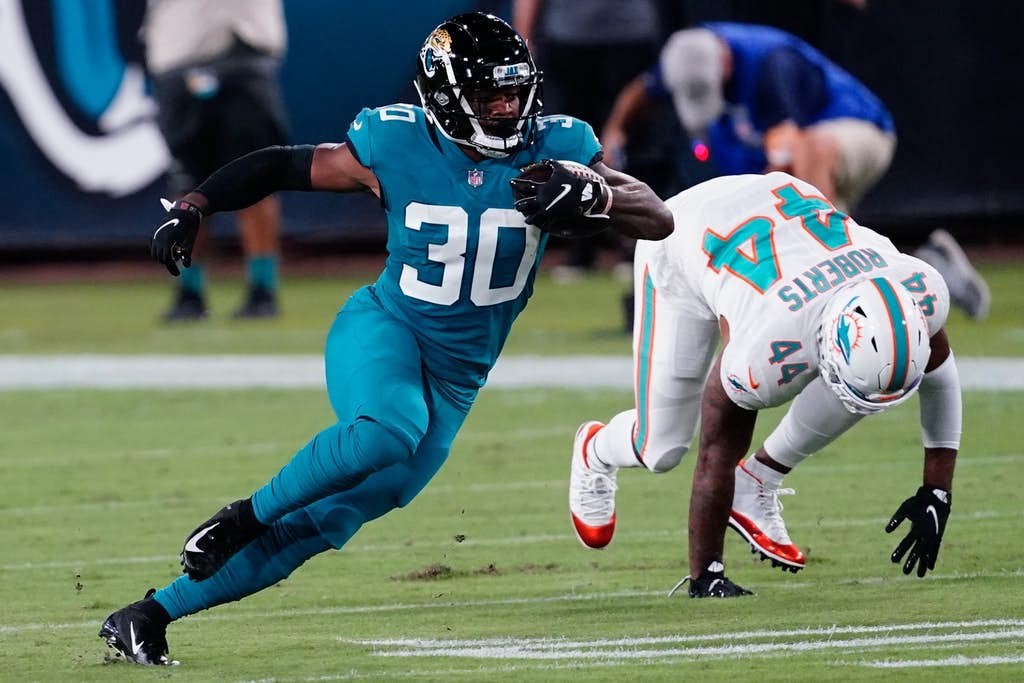
The Trends:
9th in evaded tackles
6th in yards created
9th in carries
7th in targets
The Takes:
Sometimes the entire league misses on a guy. Framing James Robinson’s breakout critically is pointless. He’s a hundred bucks you found in your pocket. Who cares if it’s a bit crinkled?
The undrafted rookie out of Illinois State was practically unheard of, until two weeks before the season. Perhaps it was the fresh eyes of a new coaching staff that worked in the 22-year-old’s favor. Robinson managed to surpass 3 other backs on the roster, and in doing so, earned the largest opportunity share in the NFL.
Looking at Robinson, it’s not surprising he slipped through the cracks. Speed is what pops most on tape, and he’s not exactly a burner. We’ve seen athletes of his archetype blossom at the running back position previously: Kareem Hunt and Aaron Jones don’t rely on tremendous top-end speed, instead possessing the explosiveness to make hard cuts upfield, the balance to withstand contact, and the receiving ability to maintain relevance regardless of game script. All that along with a dash of “just being good at their job.”
How do we know James Robinson is good at his job and not just the product of ridiculous usage? He’s actually out-performed his volume. Despite not being on a good team, ranking 9th in carries and 7th in targets, Robinson is providing above-replacement-level production, ranking 7th in rushing yards and 3rd in receiving yards.
What’s more, the undrafted back is churning out consistent yardage. The Jaguars rely on him to move the chains, and he has not disappointed in a way we sometimes see from Saquon Barkley or Leonard Fournette — players whose efficiency lags carry-to-carry, but is supplemented by the occasional splash play.
The warning signs I’m observing have nothing to do with the play of James Robinson, who at this point looks like a bonafide NFL starter. Instead, it has to do with his team context. Jacksonville has failed to score 20 points in 3 out of 7 games. Robinson’s league-leading opportunity share hasn’t been reflected in his red zone touches where he ranks 17th, or his goal line work, where he only has 1 such carry on the season. Therefore, the 6 touchdowns scored is surprising and likely unsustainable.
The Verdict: James Robinson is not a big play maker, but he’s versatile and skilled, with enough opportunity to make him a solid HOLD.
Brandon Aiyuk
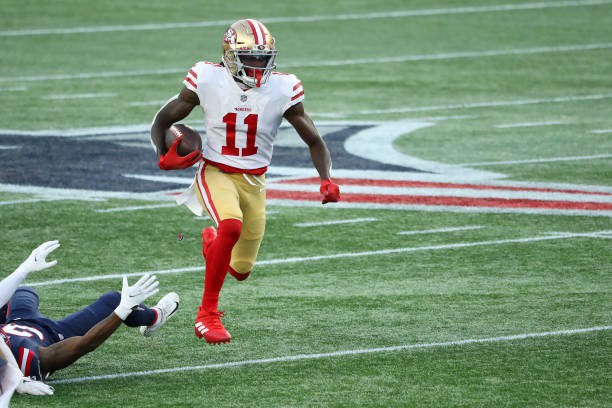
The Trends:
4.4 average yards after catch
Hasn’t seen a snap share below 70% all year
Seeing a target of 20 or more yards on 15.6% of targets
The Takes:
There’s very few teams that don’t have a defined #1 receiver. Coming into the 2020 season, it was believed Deebo Samuel would assume that mantle, upon returning from his foot injury. After all, he had a terrific rookie campaign, where he ended the season with 808 receiving yards to go along with 159 rushing yards, and 6 total touchdowns.
Samuel was the latest dynamic playmaker to have their skills creatively utilized by head coach Kyle Shanahan. After the drafting of first-round wideout Brandon Aiyuk, many saw it as San Francisco doubling down on their approach at the wide receiver position and acquiring another yards-after-catch specialist.
Not to put an Ice Cube on the Deebo hype, but it appears the drafting of Brandon Aiyuk was birthed from a different motive. Considered a reach by many, the 49ers selected the explosive playmaker with the 25th pick to be their go-to option on the outside. Aiyuk has shown unique talent as a hybrid playmaker, comfortable producing in space like Samuel, but also adept as a downfield threat.
I said it before talking about D.K. Metcalf: The holy grail at the wide receiver position is a player who wins down field as well as after the catch. By demonstrating they can win in these two areas, they make themselves available for an expanded role. Right now, San Francisco has a need for playmakers to step up.
In the last two games, Aiyuk has amassed over 147 air yards to Samuel’s -42. What this says to me, is that Samuel is being used as a gadget player, while Aiyuk is being used more traditionally. George Kittle is undoubtedly the primary receiving option on this team, but there’s room for another fantasy-friendly pass-catcher on this offense.
A detail worthy of note: The 49ers have been in the bottom half of the league in pass attempts per game, meaning targets could be at a premium. However, that figure will likely rise with the insertion of Jimmy Garappolo, who has surpassed 250 passing yards in every game he’s been healthy, the most recent of which floated Aiyuk’s production to the tune of 6 receptions on 7 targets for 115 yards.
The Verdict: Whether combing through the numbers or watching the tape, you’re likely impressed with what you’ve seen from the Arizona State product. He’s just getting acclimated to a professional offense. Deebo didn’t see his first 100 yard game until week 10 of last season. This upcoming week, the 49ers play the Seahawks, who can’t stop anybody. I expect to hear sirens as Aiyuk torches Seattle’s feeble secondary.
Josh Jacobs
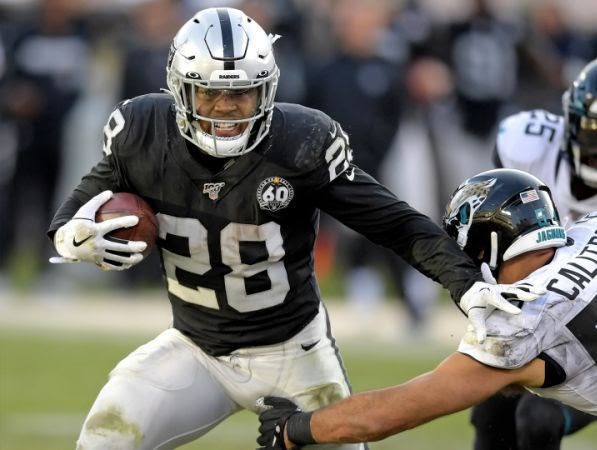
The Trends:
5th in carries
6th in evaded tackles
11th in red zone touches
4 targets per game
The Takes:
The first three trends are more impressive when we consider Jacobs’ week 6 bye. His usage has been favorable for drafters, and the Raiders as a whole have been a decent football team. Some were concerned for the second-year back’s usage as a receiver, who finds himself in a backfield littered with satellite backs.
So why then, has Josh Jacobs underwhelmed? He’s been excruciatingly touchdown dependent, and disappointingly inefficient. His 3.9 yards per touch is abysmal, and his incredible volume has yet to translate to a game with 100 rushing yards. The defensive fronts have admittedly been challenging, but the schedule doesn’t soften much down the stretch, with matchups against the Chargers and Colts in weeks 15 and 16 (fantasy playoffs/championship).
Drafted out of Alabama in 2019, Jacobs was a somewhat polarizing prospect. He looked great on tape, displaying tremendous balance and fluidity. The efficiency metrics were absurd, but he never had to endure a substantial workload and underwhelmed in his athletic testing.
Now in his second year, Jacobs’ body could be struggling to handle the rigors of the position. The elusiveness displayed in college is still showing up this season, but he hasn’t been able to turn evaded tackles into yards created at the rate we’d hope for from a 1st round talent. This can be attributed to two things: an underperforming Raiders’ offensive line, or Jacobs’ lack of acceleration.
The answer lies somewhere in-between. Jacobs is a one-speed runner. The magic behind his production has been his ability to maintain that one speed throughout the duration of a run; whether spinning, cutting, or deflecting contact. If Jacobs’ momentum is stopped, he has to re-accelerate, which is not a highlight of his skillset. If the blocking was stronger, Jacobs would undoubtedly benefit. If he was faster, he might be able to compensate.
The Verdict: Because of Gruden’s commitment to grinding out tough yards, and the Raiders general competency, Jacobs retains touchdown upside. He’s getting nearly 4 red zone touches and a goal line touch per game. Be that as it may, 1 carry of 15 or more yards on 116 carries is unacceptable. If you have a solid ensemble of running backs and can get RB1 value for Jacobs, I recommend you SELL.


